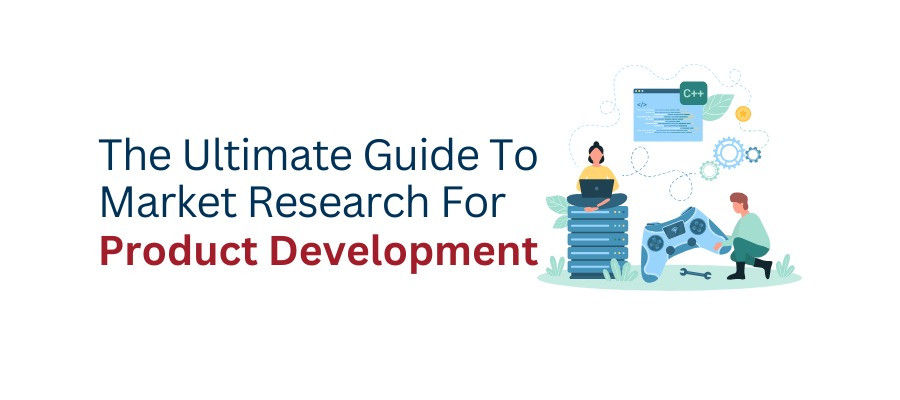The Ultimate Guide To Market Research For Product Development

Launching a new product is exciting, but even the most innovative ideas can miss the mark without consistent market research. Market research is the foundational backbone of delivering a successful product. From helping Product Owners understand consumer demands to identify the latest market trends, effective market research is enough to mitigate development risks. This guide will walk you through essential steps to conduct market research that ensures your product enters the market and thrives.
Why Does Product Development Need In-Depth Market Research?
Imagine you’ve got an idea that feels like a sure hit. You’re passionate about it but hesitate when sharing it with others. They ask tough questions about the market, consumer behavior, and trends you hadn’t considered. Simply having a gut feeling isn’t enough to secure investor interest or give your team the confidence they need.
This is where market research comes in. It provides you with complex data—insights crucial for making informed decisions about your product. Market research allows you to validate your ideas, understand your target audience, and fine-tune your product before it hits the shelves. Whether starting from scratch or improving an existing product, research is your roadmap to success.
Types of Market Research You Need
Understanding the different types of market research is vital to gathering the correct data. Here's a complete breakdown of different categories of market research:
1. Quantitative Research
This type focuses on numbers—how many people want your product, how much they’re willing to pay, and what market trends indicate. It’s all about the measurable data that gives you a broad understanding of market demand and consumer behavior.
2. Qualitative Research
While quantitative research tells you the “what,” qualitative research digs into the “why.” It explores consumer motivations, preferences, and opinions through focus groups or in-depth interviews. This type of research provides context, helping you understand the reasons behind the numbers.
3. Primary Research
This basic research step involves collecting data directly from the target market. Whether through surveys, focus groups, or interviews, this is firsthand information specific to your product and audience. It’s invaluable for product development because it’s tailored to your unique needs.
4. Secondary Research
Secondary research uses existing data, such as industry reports, competitor analysis, and market trends. While it’s not as tailored as primary research, it’s a great starting point for understanding the broader market landscape and identifying potential opportunities or threats.
Steps to Conduct Effective Market Research
To ensure your product development process is on the right track, follow these six steps for conducting thorough market research:
Step 1: Start with Exploratory Research
Exploratory research makes you dive deep into the unknown. It’s about gathering broad data to understand the market landscape, identify gaps, and spot emerging trends. This phase will refine your research focus and set the stage for more detailed inquiries.
Step 2: Define Clear Research Objectives
After your exploratory research, narrow your focus with specific questions to find answers. Whether it’s understanding customer needs, determining the right price point, or identifying the most effective marketing channels, having clear objectives will guide your research and ensure you gather actionable insights.
Step 3: Determine the Scope of Your Research
Set boundaries for your research. Decide where primary data is necessary and where secondary data will suffice. This step helps you manage resources efficiently and ensures your research efforts are focused and relevant.
Step 4: Choose the Right Research Tools or Partners
The market research tools you choose directly impact your research process. Whether conducting surveys, organizing focus groups, or analyzing data, ensure the tools are user-friendly and capable of capturing the needed data. If you’re outsourcing the research, select partners with expertise in your industry.
Step 5: Conduct Concept Testing
Before fully committing to the product idea, you must conduct concept testing. Create a minimum viable product (MVP) and present it to a focus group. Gather feedback on the product’s features, usability, and price point. This step is crucial for refining your product before a full-scale launch.
Step 6: Analyze and Apply the Data
Once you’ve collected the data, it’s time to analyze it and apply the insights to your product development process. Look for patterns, validate your initial assumptions, and make informed decisions to increase your product’s chances of success in the market.
Real-World Example: How Market Research Drives Success?
Consider the case of Organic Valley, a U.S. farming cooperative that used market research to streamline its product development process. By conducting quantitative analysis and concept testing, they identified consumer preferences early on, allowing them to refine their product before launch. This approach saved time and resources, leading to a more successful product introduction.
Let’s Turn Market Research Into Action
Market research isn’t just a box to tick off in your product development process; it’s a critical step to make or break your product’s success. By understanding your market, listening to your customers, and using data to inform your decisions, you can develop products that meet market needs and stand out.
Whether you’re launching a new product or improving an existing one, the insights gained from market research will give you the confidence to move forward, knowing you’re on the right track. So, what’s the next big idea you’ve been considering? It’s time to validate it with research and turn it into a product that resonates with your audience.
Reference:
https://medium.com/@rociofernn/mastering-market-research-a-comprehensive-guide-for-product-managers-designers-61b50059eb02
https://www.mayple.com/blog/market-research



